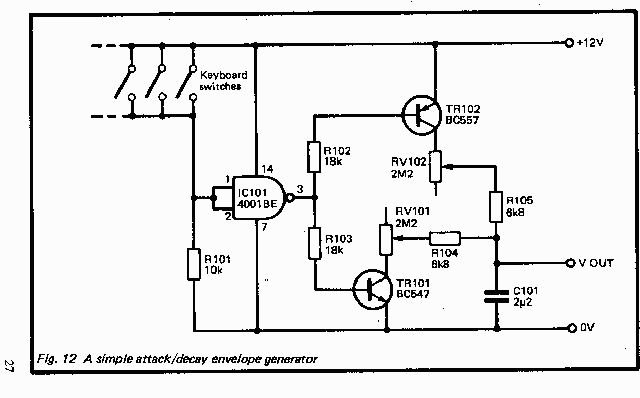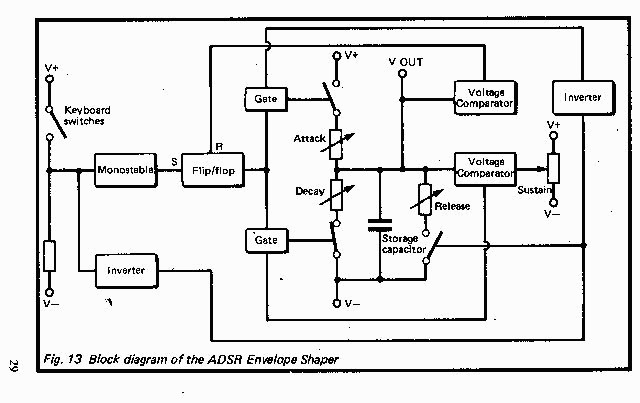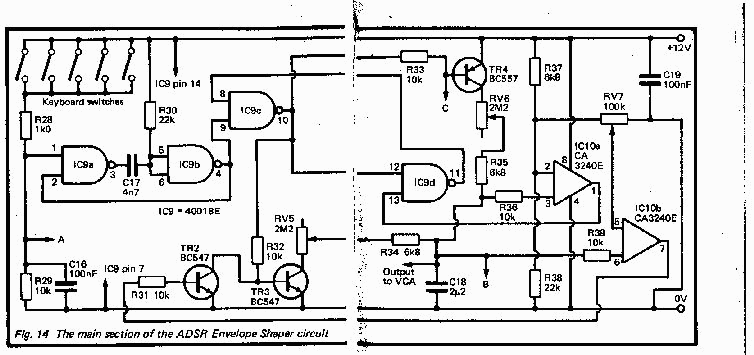<<- Back ^- Intro -^ Forward ->>
Chapter 2: EG
THE EG
Envelope Generators
If reduced to its most fundamental form an attack-decay envelope generator need have no more than five components plus some keyboard switches, as shown in the circuit diagram of Figure 11. This requires two sets of keyboard switches, one set which are normally open and another set which are normally closed. Note that with this circuit, and with the other envelope generators described here, the switches which activate the circuit are in addition to those used to generate the control voltage. In other words, with this envelope generator circuit a total of three switches per key must be available (two normally open and one normally closed type).
Operation of the circuit is very straightforward indeed. Normally capacitor Ca is connected to the negative supply rail via Rb, RVb, and the series of normally closed switches. There is no path to the positive supply rail through Ra, RVa, and the normally open switches, as all the latter will be open. Ca is therefore held in the unchanged state. If one of the keys is operated this provides a path to the positive supply rail through Ra and RVa, and also breaks the path to earth through the normally closed switches. The voltage across Ca consequently rises, as this component charges up, and it continues to do so until the full supply potential is reached or the key is released. When .the key is released the circuit returns to its original state, and Ca discharges through Rb, RVb, and the normally closed switches. The charge and discharge rates are controlled using RVa and RVb respectively, and these therefore act as the attack time and decay time controls respectively.
Although having the advantage of extreme simplicity, the envelope generator of Figure 11 is not very practical in that it requires two sets of key contacts, and one set is of the, normally closed variety (which can be difficult to arrange with some keyboards). The envelope generator circuit of Figure 12 is more practical as it requires just one set of normally open key contacts.
1C101 is one of the 2 input NOR gates from a CMOS 4001BE device, but here its two inputs are simply wired together so that it operates as a simple inverter. Normally R101 holds the input of 1C101 low, which takes the output high. This results in TrIO2, being cut off and Tr101 being biased hard into conduction. C101 is therefore held in the discharged state. If one of the keyboard switches is operated, this takes the input of 1C101 high and sends the output low. It is then TrIO2 that is switched on and TrIO1 that is cut off. C101 then charges via Trl02, RVI02, and R105. When the key is released the circuit reverts to its original state and C101 discharges by way of R104, RIOI, and TrIO1. RV101 and RV102 therefore act respectively as the decay and attack time controls. Both times are adjustable from a few milliseconds to several seconds in duration.
Attack-Decay Envelope Generator Components (Fig. 12)
Resistors (all 1/4 watt 5%) R101 10k R102,103 18k R104,105 6k8 Potentiometers RV101,102 2M2 Lin Capacitors C101 2u2 miniature polyester Semiconductors IC101 4001BE TR101 BC547 TrIO2 BC557 Miscellaneous Circuit board Two control knobs 14 pin DIL IC holder, wire etc.
ADSR Generator
Although an ADSR envelope shaper is rather more complex than an attack decay type, it does not greatly increase the cost of the synthesiser as a whole, and is probably well worth the additional expense. The block diagram of Figure 13 helps to explain the operation of the ADSR envelope generator featured here.
The flip/flop circuit operates two electronic switches, and the circuit is arranged so that when one of these s closed the other is open. This is very much like the system used in the attack/decay envelope generator described previously, and these two switches do in fact control the attack and decay phases of the envelope. Initially the attack switch is held open and the decay switch is closed, but when a key is operated this triggers a monostable multivibrator which generates a brief pulse. This pulse sets the flip/flop to its alternative state, so that the attack switch is closed and the decay switch is opened. The voltage on the storage capacitor then starts to rise, and it continues to do so until the charge potential reaches a certain threshold level. This is then detected by one of the voltage comparators which resets the flip/ flop to its original state. The storage capacitor then starts to discharge via the decay potentiometer, and it continues to do so, until a certain threshold level is reached. This level is detected by the second voltage comparator, and the sustain control enables the threshold level to be varied from zero to the peak envelope voltage. The voltage comparator cuts off the control signal to the decay switch, which is consequently opened, ending the decay phase.
There is a third electronic switch, the release switch, and this is operated from the keyboard switches via an inverter stage. This I a key is released. Thus, when a key is released, the release phase of the envelope is commenced. A further gate and inverter stage are used to ensure that when the release switch is closed the attack switch must be open. This is necessary because there is otherwise a risk that both switches would be in the closed state if the key is released early in the envelope. This could result in the circuit hanging-up in an intermediate stale, rather than immediately entering the release phase.
The main circuit of the ADSR envelope shaper is shown in Figure 14, and the rest of the circuit appears in Figure 15.
The monostable and bistable (flip/flop) circuits are each formed from two of the CMOS 2 input NOR gates of IC9. 1C9a and IC9b are used in the monostable, while IC9c and 1C9d form the basis of the flip/flop. Both are conventional circuit configurations. C16 helps to avoid spurious triggering of the monostable due to contact bounce when a key is released C18 is the charge storage capacitor, while RV5 and RV6 are respectively the decay and attack controls.
1C10 is a dual operational amplifier, but in this circuit both sections act as voltage comparators. 1C10a is the one which resets the flip/flop at the end of the attack period, while 1C10b ends the decay period in conjunction with Tr2. RV7 is used to set the required sustain level. Tr5 is the release switch, and it is driven from the keyboard circuit via inverter Tr6. Tr7 are Tr8 are used to inhibit the attack circuit when a key is released.
One problem with both the attack/decay and the ADSR envelope shapers is that they require an additional set of contacts on the keyboard. When using a proper keyboard there is riot usually any problem in having two sets of make contacts per key, but with a stylus keyboard there are obviously no switch contacts to trigger the envelope shaper. This problem is not insurmountable, and all that is needed is a simple trigger circuit of the type shown in the circuit diagram of Figure 16.
The circuit is a voltage comparator, and it compares the keyboard voltage with a low reference potential of about 120 millivolts which is supplied by R101 and R 102. With no note being played, the non-inverting input of 1C101 is taken low by R103, and the output of the circuit goes low. When a note is played, the input voltage is more than 120 millivolts, and the output of the circuit goes high, triggering the envelope shaper. In fact the input voltage will only exceed 120 millivolts when the third or higher notes on the keyboard are played. In practice this means that the lowest two keys should be omitted, and the keyboard should start at “D” rather than “C”.
R103 must have a high value so that the circuit does not significantly load the potential divider circuit in the keyboard circuit (which would cause the higher notes to sound flat). However, this makes the circuit prone to spurious triggering due to stray pick up of electrical noise in the lead to the stylus. To avoid this the lead should be kept reasonably short, and the stylus should be a type that ensures that the player is well insulated from the metal tip (the human body picks up substantial amounts of electrical noise from the environment).
ADSR Envelope Generator Components (Figs. 14 & 15)
Resistors (all 1/4 watt 5%) R28 lk R29,31,32,33,36,39,44,46 10k R30,38 22k R34,35,37,40,41,45 6k8 R42,43 100k Potentiometers RV5,6,8 2M2 linear RV7 100k linear Capacitors C16 100nF ceramic C17 4n7 miniature polyester C18 2u2 miniature polyester C19 100nF ceramic Semiconductors 1C9 4001BE IC10 CA3240E Tr2,3,5,6,7 BC547 Tr4,8 BC557 Miscellaneous Printed circuit board Four control knobs, IC holders, wire, etc.



